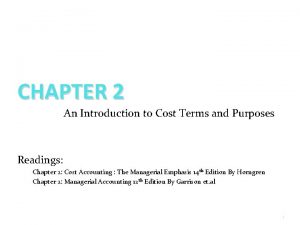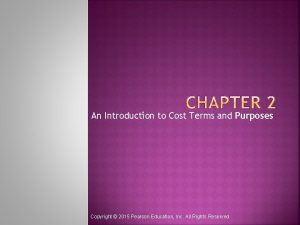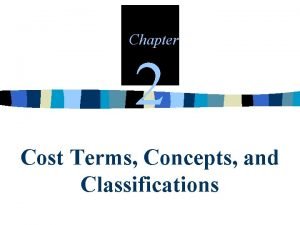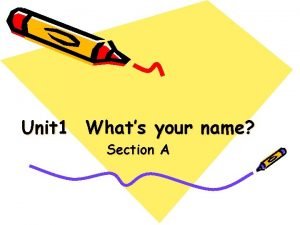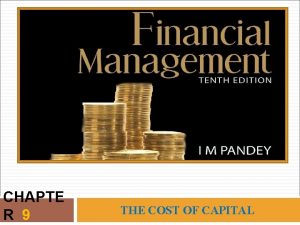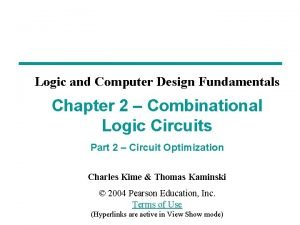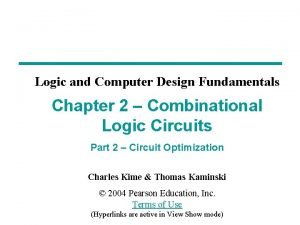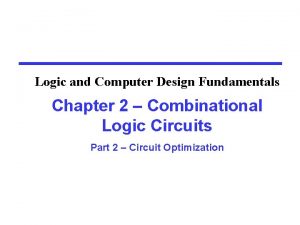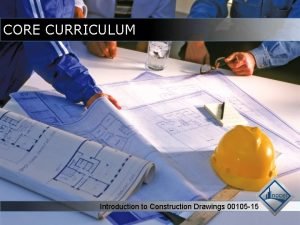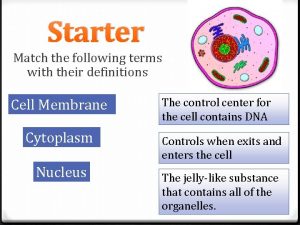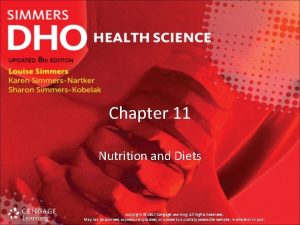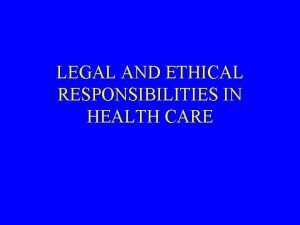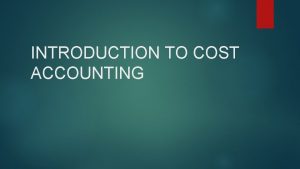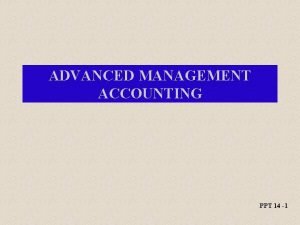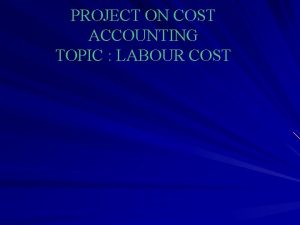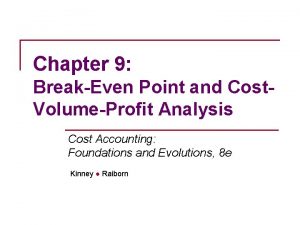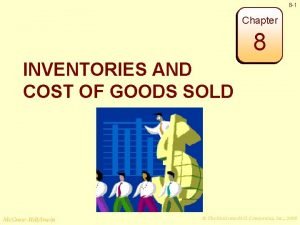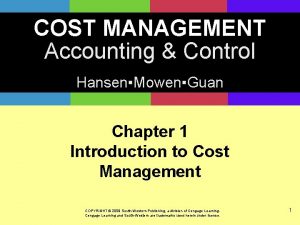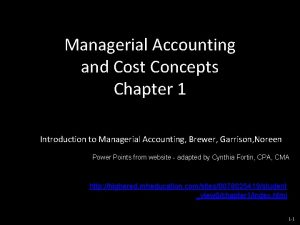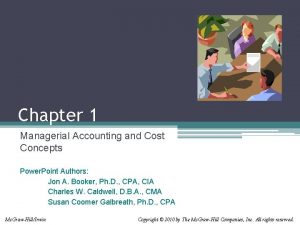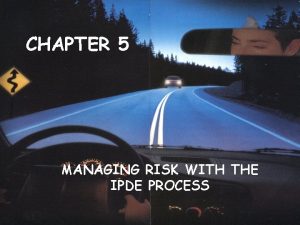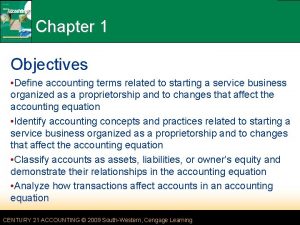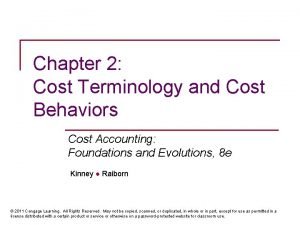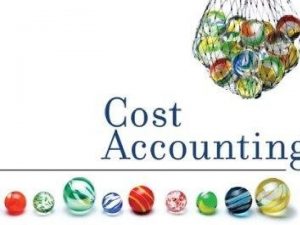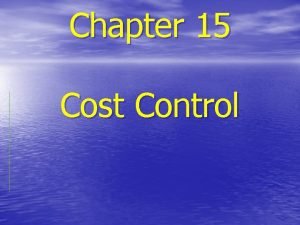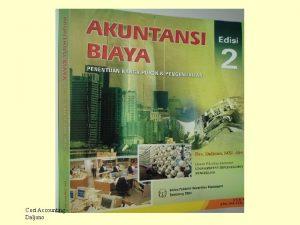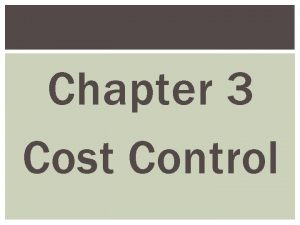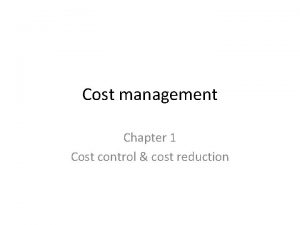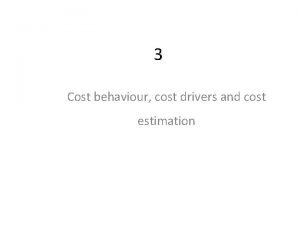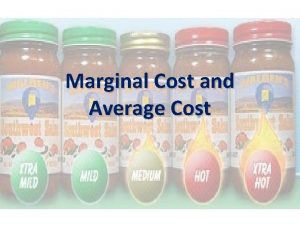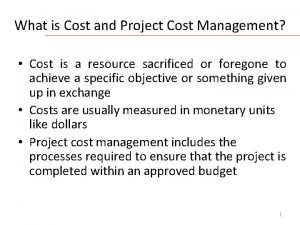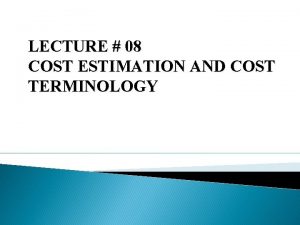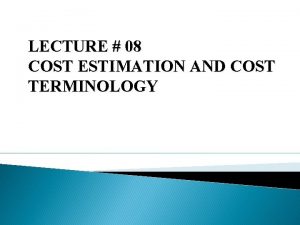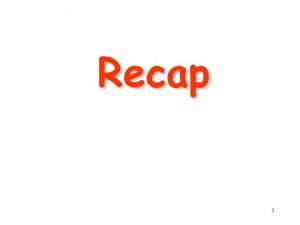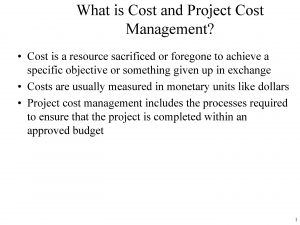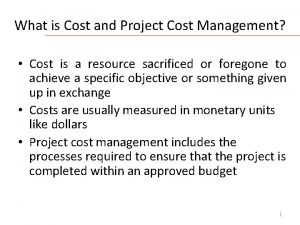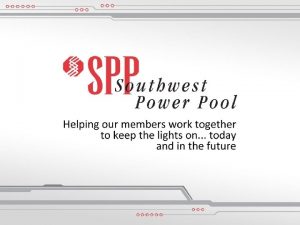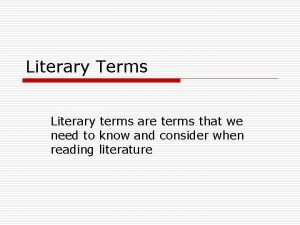CHAPTER 2 An Introduction to Cost Terms and















































- Slides: 47

CHAPTER 2 An Introduction to Cost Terms and Purposes Readings: Chapter 2: Cost Accounting : The Managerial Emphasis 14 th Edition By Horngren Chapter 2: Managerial Accounting 12 th Edition By Garrison et. al 1

Basic Cost Terminology Cost – sacrificed resource to achieve a specific objective Actual cost – a cost that has occurred Budgeted cost – a predicted cost Cost object – anything of interest for which a cost is desired 2

Cost Object Examples at BMW Cost Object Illustration Product BMW X 5 sports activity vehicle Service Dealer-support telephone hotline Project R&D project on DVD system enhancement Customer Herb Chambers Motors, a dealer that purchases a broad range of BMW vehicles Activity Setting up production machines Department Environmental, Health & Safety 3

Basic Cost Terminology Cost accumulation – a collection of cost data in an organized manner Cost assignment – a general term that includes gathering accumulated costs to a cost object. This includes: Tracing accumulated costs with a direct relationship to the cost object and Allocating accumulated costs with an indirect relationship to a cost object 4

Direct & Indirect Costs Direct costs – can be conveniently and economically traced (tracked) to a cost object Indirect costs – cannot be conveniently or economically traced (tracked) to a cost object. Instead of being traced, these costs are allocated to a cost object in a rational and systematic manner 5

BMW: Assigning Costs to a Cost Object 6

Cost Examples Direct Costs Parts Assembly line wages Indirect Costs Electricity Rent Property taxes 7

Factors Affecting Direct / Indirect Cost Classification Cost Materiality Availability of information-gathering technology Operational Design 8

Cost Behavior Variable costs – changes in total in proportion to changes in the related level of activity or volume Fixed costs – remain unchanged in total regardless of changes in the related level of activity or volume Costs are fixed or variable only with respect to a specific activity or a given time period 9

Cost Behavior, continued Variable costs – are constant on a per-unit basis. If a product takes 5 pounds of materials each, it stays the same per unit regardless of one, ten or a thousand units are produced Fixed costs – change inversely with the level of production. As more units are produced, the same fixed cost is spread over more and more units, reducing the cost per unit 10

Cost Behavior Summarized Variable Costs Total Dollars Total Change in in Change proportion with proportion output Cost per Per Unit Unchanged in relation to output Moreoutput==Morecost More Fixed Costs Unchanged in relation to output Change inversely with output More output = lower cost per unit 11

Cost Behavior Visualized 12

Other Cost Concepts Cost Driver – a variable that causally affects costs over a given time span Relevant Range – the band of normal activity level (or volume) in which there is a specific relationship between the level of activity (or volume) and a given cost For example, fixed costs are considered fixed only within the relevant range. 13

Relevant Range Visualized 14

A Cost Caveat Unit costs should be used cautiously. Since unit costs change with a different level of output or volume, it may be more prudent to base decisions on a total dollar basis. Unit costs that include fixed costs should always reference a given level of output or activity Unit Costs are also called Average Costs 15

Multiple Classification of Costs may be classified as: Direct / Indirect, and Variable / Fixed These multiple classifications give rise to important cost combinations: Direct & Variable Direct & Fixed Indirect & Variable Indirect & Fixed 16

Multiple Classification of Costs, Visualized 17

Different Types of Firms Manufacturing-sector companies – create and sell their own products Merchandising-sector companies – product resellers Service-sector companies – provide services (intangible products) 18

Types of Manufacturing Inventories Direct Materials – resources in-stock and available for use Work-in-Process (or progress) – products started but not yet completed. Often abbreviated as WIP Finished Goods – products completed and ready for sale 19

Types of Product Costs Also known as Inventoriable Costs Direct Materials Direct Labor Indirect Manufacturing – factory costs that are not traceable to the product. Other common names for this type of cost include Manufacturing Overhead costs or Factory Overhead costs. 20

Accounting Distinction Between Costs Inventoriable costs – product manufacturing costs. These costs are capitalized as assets (inventory) until they are sold and transferred to Cost of Goods Sold. Period costs – have no future value and are expensed as incurred. 21

Cost Flows The Cost of Goods Manufactured and the Cost of Goods Sold section of the Income Statement are accounting representations of the actual flow of costs through a production system. Note the importance of inventory accounts in the following accounting reports, and in the cost flow chart 22

Cost Flows Visualized 23

Cost of Goods Manufactured 24

Multiple-Step Income Statement 25

Other Cost Considerations Prime cost is a term referring to all direct manufacturing costs (labor and materials) Conversion cost is a term referring to direct labor and factory overhead costs, collectively Overtime labor costs are considered part of overhead due to the inability to precisely know the true cause of these costs 26

Different Definitions of Costs for Different Applications Pricing and product-mix decisions – may use a “super” cost approach (comprehensive) Contracting with government agencies – very specific definitions of cost for “cost plus profit” contracts Preparing external-use financial statements – GAAPdriven product costs only 27

Different Definitions of Costs for Different Applications 28

Three Common Features of Cost Accounting & Cost Management Calculating the cost of products, services, and other cost objects 2. Obtaining information for planning & control, and performance evaluation 3. Analyzing the relevant information for making decisions 1. 29

Cost Categories n Association with cost object q n n Cost object is anything for which management wants to collect or accumulate costs Reaction to changes in activity Classification on the financial statements 30

Cost Categories n Association with cost object q q Direct—traceable to a cost object Indirect—not conveniently or practically traceable to a cost object n n treated as overhead allocated 31

Cost Categories n n Association with cost object Reaction to changes in activity q q Variable Fixed Mixed Step Relevant Range—normal operating range 32

Total and Unit Cost Behavior Variable Cost Fixed Cost Total Cost Unit Cost Varies in direct proportion to changes in activity Remains constant throughout the relevant range Varies inversely with changes in activity throughout the relevant range 33

Cost Categories n Classification on the financial statements q q q Unexpired—balance sheet assets Expired—income statement expenses Product—inventoriable costs n n q Prime—direct material and direct labor Conversion—direct labor and overhead Product costs are unexpired before sale Product costs are expired when sold Period—expensed in period incurred 34

Product Costs n Direct material q n Direct labor q n Measurable part of a product Labor used to manufacture a product or perform a service Overhead q Indirect production cost 35

Period Costs n n Selling and administrative costs Distribution costs q q Cost to warehouse, transport, and/or deliver a product or service Major impact on managerial decision making 36

Conversion Process Change Inputs into Outputs Input Output Purchase raw materials or supplies Product or Service CONVERSION © 2013 Cengage Learning. All Rights Reserved. May not be scanned, copied, duplicated, or posted to a publicly accessible website, in whole or in part. 37

Cost Accumulation in a Manufacturing Company Materials Inventory Work in Process Inventory Finished Goods Inventory Balance Sheet Cost of Goods Sold Income Statement © 2013 Cengage Learning. All Rights Reserved. May not be scanned, copied, duplicated, or posted to a publicly accessible website, in whole or in part. 38

Product Cost – Direct n Direct Material q n Conveniently and economically traced to cost object Direct Labor q q q to manufacture a product or perform a service includes wages paid to direct labor employees, production bonuses, and payroll taxes may include holiday and vacation pay, insurance, and retirement benefits 39

Product Cost – Indirect Overhead—indirect production costs Fringe benefits, if cannot be easily traced to product Overtime, if due to random scheduling Cost of quality Prevention costs Appraisal costs Failure costs 40

Product Cost Behavior Direct Material Variable Direct Labor Variable Overhead Variable, fixed, or mixed 41

Overhead Cost Allocation Assign indirect costs to one or more cost objects § To determine full absorption cost (GAAP) To motivate management To compare alternative courses of action for planning, controlling, and decision making Allocation process should be rational and systematic 42

Allocating Overhead Actual vs. Normal Product Cost Direct Materials Actual Cost System Actual Normal Cost System Actual Direct Labor Actual Overhead Actual Predetermined Overhead Rate © 2013 Cengage Learning. All Rights Reserved. May not be scanned, copied, duplicated, or posted to a publicly accessible website, in whole or in part. 43

Predetermined Overhead Rate n n Allows overhead to be assigned during the period Compensates for fluctuations q q that are not related to activity level in activity level that do not affect fixed overhead 44

Questions What is the difference between a fixed and variable cost? What are three components of product cost? What are three inventory accounts for a manufacturing company? 45

Ethical Issues Expired costs—not on the balance sheet Period costs—not inventory Product costs—not selling or administrative costs Direct labor—not overstated Ending inventory—not overstated 46

End Of Lecture 2 47
 Chapter 2 an introduction to cost terms and purposes
Chapter 2 an introduction to cost terms and purposes An introduction to cost terms and purposes
An introduction to cost terms and purposes Like terms and unlike terms in polynomials
Like terms and unlike terms in polynomials Math combining like terms
Math combining like terms Cost terms concepts and classifications
Cost terms concepts and classifications Cost accumulation and cost assignment
Cost accumulation and cost assignment Cost accumulation and cost assignment
Cost accumulation and cost assignment Cost accumulation and cost assignment
Cost accumulation and cost assignment Cost accumulation and cost assignment
Cost accumulation and cost assignment Dennis geyer
Dennis geyer Objectives of standard costing
Objectives of standard costing Distinguish between average cost and marginal cost
Distinguish between average cost and marginal cost Cost control and cost reduction difference
Cost control and cost reduction difference Similarities between job order costing and process costing
Similarities between job order costing and process costing Ordering cost and carrying cost
Ordering cost and carrying cost Opportunity cost vs trade off
Opportunity cost vs trade off Cost control and cost reduction project report
Cost control and cost reduction project report Cost control and cost reduction project report
Cost control and cost reduction project report Cost structure refers to the relative proportion of
Cost structure refers to the relative proportion of Whats your name bob
Whats your name bob Manufacturing cost vs non manufacturing cost
Manufacturing cost vs non manufacturing cost Job costing vs. process costing
Job costing vs. process costing Whats financial leverage
Whats financial leverage Controllable expenses examples
Controllable expenses examples Manufacturing cost vs non manufacturing cost
Manufacturing cost vs non manufacturing cost Material price variance
Material price variance Book value of debt
Book value of debt Literal cost gate input cost
Literal cost gate input cost Literal cost gate input cost
Literal cost gate input cost Literal cost gate input cost
Literal cost gate input cost An engineer's scale is set up in multiples of
An engineer's scale is set up in multiples of Match the following terms with their definitions.
Match the following terms with their definitions. Chapter 11 nutrition and diets key terms
Chapter 11 nutrition and diets key terms Chapter 11 nutrition and diets
Chapter 11 nutrition and diets Chapter 5 legal and ethical responsibilities key terms
Chapter 5 legal and ethical responsibilities key terms Weld map symbols
Weld map symbols Cost accounting concept
Cost accounting concept Kaizen costing ppt
Kaizen costing ppt Labour cost accounting
Labour cost accounting Margin of safety formula in dollars
Margin of safety formula in dollars Chapter 8 inventories and the cost of goods sold
Chapter 8 inventories and the cost of goods sold Cost and management accounting chapter 1
Cost and management accounting chapter 1 Relevant range managerial accounting
Relevant range managerial accounting Chapter 1 managerial accounting and cost concepts
Chapter 1 managerial accounting and cost concepts Chapter 5 section 4 the minor parties reviewing key terms
Chapter 5 section 4 the minor parties reviewing key terms Chapter 4 managing risk with the ipde process
Chapter 4 managing risk with the ipde process Accounting chapter 1 terms
Accounting chapter 1 terms Chapter 3 careers in health care key terms
Chapter 3 careers in health care key terms
